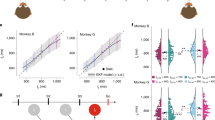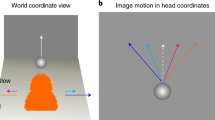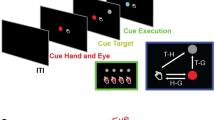Abstract
In sensorimotor integration, sensory input and motor output signals are combined to provide an internal estimate of the state of both the world and one's own body. Although a single perceptual and motor snapshot can provide information about the current state, computational models show that the state can be optimally estimated by a recursive process in which an internal estimate is maintained and updated by the current sensory and motor signals. These models predict that an internal state estimate is maintained or stored in the brain. Here we report a patient with a lesion of the superior parietal lobe who shows both sensory and motor deficits consistent with an inability to maintain such an internal representation between updates. Our findings suggest that the superior parietal lobe is critical for sensorimotor integration, by maintaining an internal representation of the body's state.
This is a preview of subscription content, access via your institution
Access options
Subscribe to this journal
Receive 12 print issues and online access
$209.00 per year
only $17.42 per issue
Buy this article
- Purchase on Springer Link
- Instant access to full article PDF
Prices may be subject to local taxes which are calculated during checkout






Similar content being viewed by others
References
Bálint, R. Seelenlähmung des 'schauens', optische ataxie, raümliche störung der aufmerksam. Monatschr. Psychiat. Neurol. 25, 51–81 (1909).
Holmes, G. Disorders of visual orientation. Br. J. Ophthalmol. 2, 449–468 (1918).
McFie, J., Piercy, F. J. & Zangwill, O. L. Visual-spatial agnosia associated with lesions of the right cerebral hemisphere. Brain 73, 167–170 (1950).
DeRenzi, E. Disorders of Space Exploration and Cognition (John Wiley, Chichester, 1982).
Corbetta, M., Miezin, F. M., Shulman, G. L. & Petersen, S. E. A PET study of visuospatial attention. J. Neurosci. 13, 1202–1226 (1993).
Corbetta, M., Shulman, G. L., Miezin, F. M. & Petersen, S. E. Superior parietal cortex activation during spatial attention shifts and visual feature conjunction. Science 270, 802– 805 (1995).
Grafton, S. T., Fagg, A. H., Woods, R. P. & Arbib, M. A. Functional-anatomy of pointing and grasping in humans. Cereb. Cortex 6, 226–237 (1996).
Clower, D. M. et al. Role of posterior parietal cortex in the recalibration of visually guided reaching. Nature 383, 618 –621 (1996).
Andersen, R. in Handbook of Physiology vol. V Part II (eds Plum, F. & Mountcastle, V. B.) 483–518 (American Physiological Society, Rockville, Maryland, 1987).
Milner, A. D. & Goodale, M. The Visual Brain in Action (Oxford Univ. Press, Oxford, 1995).
Jeannerod, M. The Cognitive Neuroscience of Action (Blackwell, Oxford, 1997).
Husain, M. in Vision and Visual Dysfunction vol. 13 (ed. Stein, J. F.) 12 –43 (Macmillan, Basingstoke, UK, 1991 ).
Mountcastle, V. B., Lynch, J. C., Georgopoulos, A. P., Sakata, H. & Acuna, C. Posterior parietal association cortex of the monkey: command function for operations within extrapersonal space . J. Neurophysiol. 38, 871– 907 (1975).
Bushnell, M. C., Goldberg, M. E. & Robinson, D. L. Behavioural enhancement of visual responses in monkey cerebral cortex. I. modulation in posterior parietal cortex related to selective visual attention. J. Neurophysiol. 46, 755 –772 (1981).
Duhamel, J. R., Colby, C. L. & Goldberg, M. E. The updating of the representation of visual space in parietal cortex by intended eye movements. Science 255, 90–92 (1992).
Andersen, R. A., Snyder, L. H., Bradley, D. C. & Xing, J. Multimodal representation of space in the posterior parietal cortex and its use in planning movements. Annu. Rev. Neurosci. 20, 303–330 (1997).
Rizzolatti, G., Fogassi, L. & Gallese, V. Parietal cortex: from sight to action. Curr. Opin. Neurobiol. 7, 562–567 (1997).
Wolpert, D. M., Ghahramani, Z. & Jordan, M. I. Are arm trajectories planned in kinematic or dynamic coordinates? An adaptation study. Exp. Brain Res. 103 , 460–470 (1995).
Wolpert, D. M. Computational approaches to motor control. Trends Cogn. Sci. 1, 209–216 (1997).
Goodwin, G. C. & Sin, K. S. Adaptive Filtering Prediction and Control (Prentice-Hall, Englewood Cliffs, New Jersey, 1984).
Wolpert, D. M., Ghahramani, Z. & Jordan, M. I. An internal model for sensorimotor integration. Science 269, 1880–1882 (1995).
Mesulam, M. M. Principles of Behavioural Neurology: Tests of Directed Attention and Memory (Davis FA, Philadelphia, 1985).
Jeannerod, M., Michel, F. & Prablanc, C. The control of hand movements in a case of hemianaesthesia following a parietal lesion. Brain 107, 899–920 (1984).
Rothwell, J. C. et al. Manual motor performance in a deafferented man. Brain 105, 515–542 (1982).
Wann, J. P. & Ibrahim, S. F. Does limb proprioception drift . Exp. Brain Res. 91, 162– 166 (1992).
Perenin, M. T. & Vighetto, A. Optic ataxia: a specific disruption in visuomotor mechanisms. I. different aspects of the deficit in reaching for objects. Brain 111, 643–674 (1988).
Critchley, M. The Parietal Lobes (Edward Arnold, London, 1953 ).
Mennemeier, M. S. et al. Contributions of the parietal and frontal lobes to sustained attention and habituation. Neuropsychologia 32, 703–716 (1994).
Holliday, I. E., Kennard, C. & Ruddock, K. H. Rapid fading of visual sensations in a subject with a parietal occipital tumor. Ophthalmic Physiol. Opt. 5, 149–156 (1985).
Head, H. & Holmes, G. Sensory disturbances from cerebral lesions. Brain 34, 102– 213 (1912).
Vallar, G. & Perani, D. The anatomy of unilateral neglect after right-hemisphere stroke lesions. A clinical/CT-scan correlation study in man. Neuropsychologia 24, 609– 622 (1986).
Mattingley, J. B., Husain, M., Rorden, C., Kennard, C. & Driver, J. Motor role of human inferior parietal lobe revealed in unilateral neglect patients. Nature 392, 179–182 (1998).
Posner, M. I., Walker, J. A., Friedrich, F. J. & Rafal, R. D. Effects of parietal injury on covert orienting of attention. J. Neurosci. 4, 1863–1874 (1984).
Pardo, J. V., Fox, P. T. & Raichle, M. E. Localization of a human system for sustained attention by positron emission tomography. Nature 349, 61–64 (1991).
Coull, J. T., Frith, C. D., Frackowiak, R. S. J. & Grasby, P. M. A frontoparietal network for rapid visual information-processing: a PET study of sustained attention and working-memory. Neuropsychologia 34, 1085–1095 (1996).
Friedrich, F. J., Egly, R., Rafal, R. D. & Beck, D. Spatial attention deficits in humans: a comparison of superior parietal and temporal-parietal junction lesions. Neuropsychology 12, 193 –207 (1998).
Milner, A. D. in Parietal Lobe Contributions to Orientation in 3D Space (eds Thier, P. & Karnath, H. O.) 3–22 (Springer-Verlag, Heidelberg, 1997).
Acknowledgements
We thank PJ for participating in the study and Jon Driver and Tobe Freeman for helpful discussions. This work was supported by a grant from the Wellcome Trust and the Royal Society.
Author information
Authors and Affiliations
Corresponding author
Rights and permissions
About this article
Cite this article
Wolpert, D., Goodbody, S. & Husain, M. Maintaining internal representations: the role of the human superior parietal lobe. Nat Neurosci 1, 529–533 (1998). https://doi.org/10.1038/2245
Received:
Accepted:
Issue Date:
DOI: https://doi.org/10.1038/2245
This article is cited by
-
A multimodal submillimeter MRI atlas of the human cerebellum
Scientific Reports (2024)
-
Brain Anatomy in Boys with Conduct Disorder: Differences Among Aggression Subtypes
Child Psychiatry & Human Development (2024)
-
Stand up to better pay attention, sit down to better subtract: a new perspective on the advantage of cognitive-motor interactions
Psychological Research (2023)
-
rTMS over the human medial parietal cortex impairs online reaching corrections
Brain Structure and Function (2023)
-
Sensory Phenotypes in Autism: Making a Case for the Inclusion of Sensory Integration Functions
Journal of Autism and Developmental Disorders (2023)



